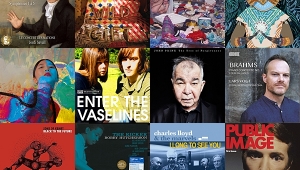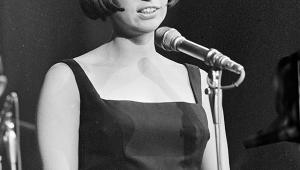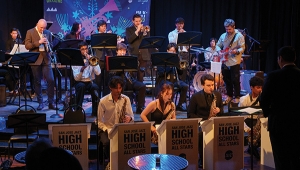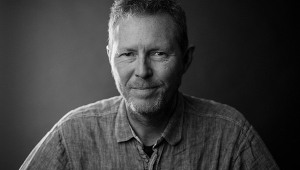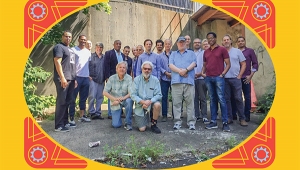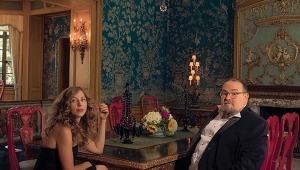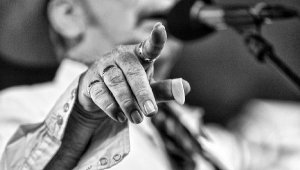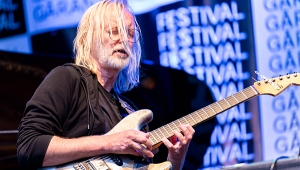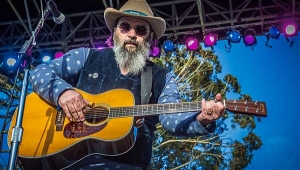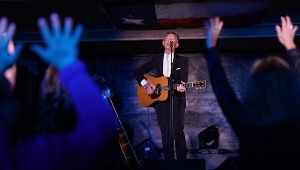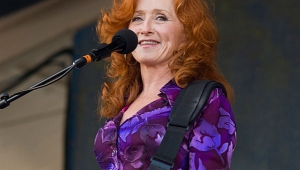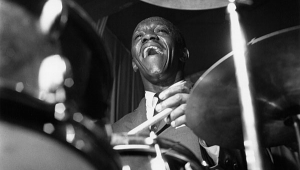| Columns Retired Columns & Blogs |
Center Stage: Guitarist Albert Lee in surround sound
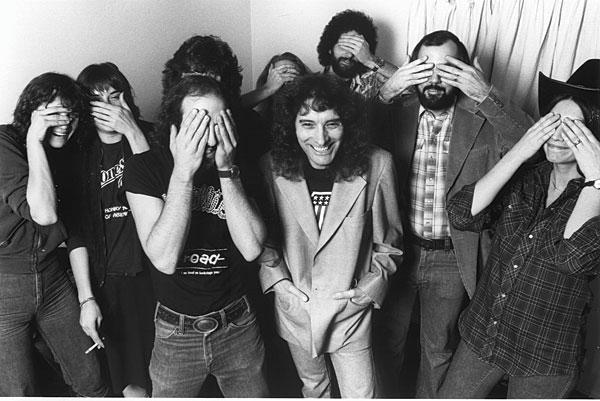
Humble, unprepossessing, modest are not words normally associated with lead guitarists, or lead singers, or lead anything. But Albert Lee, the Fender Telecaster devotee, has, by all accounts, always been refreshingly down to earth. The other unusual quality about Lee is that he's an English guitarist who, in country music, can hold his own against any American player.
Lee was the only major English guitarist of the 1970s who decided to follow his first love, country music, and not even attempt to match the blues-rock players who then dominated the UK and US rock charts. "In the '70s, everybody was listening to B.B. King and Jimi Hendrix. There were times when I felt like the odd man out. I can't really get into that stuff, and I can't play it the way they do."
Lee had become a professional musician while still a teenager, playing with UK R&B singer Chris Farlowe and the Thunderbirds, before fronting a succession of increasingly successful country-rock acts, including Country Fever, Poet & the One Man Band, and, finally Heads Hands & Feet, who released three albums before dissolving in 1973.
"I thought about how much I liked country music and really liked to play it," Lee said recently after playing a Cherry Bombs reunion gig in Nashville featuring Emmylou Harris, Rodney Crowell, and Tony Brown, among others. "Prior to that, I'd been buying Buck Owens and George Jones records, or whatever I could get hold of. So I put together a country band. By the time I was in Heads Hands & Feet, we were playing certain country clubs in the UK, and they didn't like a lot of the stuff that we were doing. We were playing the Byrds and Burritos, and it was too rock'n'roll for them. They wanted Jim Reeves and Johnny Cash.
"I'd met up with the Everly Brothers guitar player, Don Peake, in London, and he said, 'Boy, you should go to the States. They'd love your playing there.' I said, 'There are lots of great players there, people I idolize—there wouldn't be room for me.' But when I finally got here, in '70 and '71, I realized that this is where I should be. In the UK, everybody wanted Clapton and Jimi Hendrix playing Gibsons through Marshall stacks, and I was playing Telecaster through a 4x10 Bassman."
Lee's move to the US paid off. After arriving here, he landed steady gigs playing the world with fellow Englishman Joe Cocker and, in perhaps his best-known brush with fame, replacing the great James Burton in the touring version of Emmylou Harris's Hot Band.
"I was in the Hot Band in '76–'77, but I think you're always part of the family. After I joined, James went off to play with Elvis, of course, but there were certain things that Brian Ahern [Harris's producer and husband] wanted him to do on some of the albums after I joined. In those situations, it was great, because there I was in the studio with my hero. If I played electric, he would play Dobro. And if he played electric, I would play mandolin. It was so much fun.
"When I was there, Rodney [Crowell] played rhythm and sang harmonies with Emmy. And it was Hank DeVito [pedal steel] and Glen D. Hardin [piano], Emory Gordy Jr. [bass], and John Ware [drums]. I left to do my first solo record, the Hiding record, which I ended up doing most of with the Hot Band. We did the basic tracks, and Brian produced. But then I had to decide what to do. Do I try and get back into the Hot Band? She'd gotten another guitar player, Frank Reckard, who's a really fine player but not in the same style as me—plays a Gibson—so that kind of changed the sound of the band. Prior to that, it was all Telecasters. What I should have done was put a band together. But in the meantime I met up with Eric Clapton—we were old friends from the '60s—and he said, 'Hey, do you want to come out on the road?' That was an easy decision, and it lasted five years."
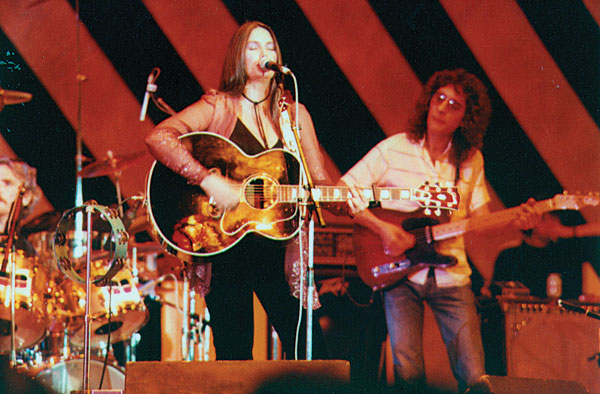
Normally, one band with two guitarists, both used to playing lead, is a recipe for disaster, or at least for one player to make a quick exit. The key to Lee's longevity was his agreeable personality.
"Eric was very gracious. He let me sing a couple of songs, and I played solos here and there. He was going through a difficult period at the time, and he fired the whole band twice, and I managed to survive both purges. But I knew one day my number would be up, and five years later, it was. But we're still good friends, and I've done things with him—the 2002 Concert for George, and the 2007 Crossroads Guitar Festival."
Lee has now dipped a toe in audiophile waters with the release of Tearing It Up, a recording on Blu-ray disc that contains multiple surround-sound mixes. For the new album, Lee partnered with Dr. Mark Waldrep, an engineer and producer who is a great believer in surround sound, no fan of vinyl, and the owner of a small audio/visual label, AIX Records. Tearing It Up was recorded in 5.1 channels and filmed in high definition in 2006 in Zipper Auditorium, at the Colburn School for the Arts, in downtown L.A. Along with a 3D Blu-ray disc of country singer Mark Chesnutt, Tearing It Up is one of the two latest examples of Waldrep's continuing crusade for surround sound.
"What I'm doing is having a private concert," Waldrep says from his office in L.A. "I didn't have to buy an expensive ticket. I didn't have to truck east of the 405 freeway at eight o'clock at night. It's wonderful to have HD video, and at the end of the day you get to sit there in a dark room and with a nice surround-sound system—which is obviously my preference in a big way—and create an audio experience you can't do with vinyl or CDs."
For Waldrep, as it is for all recording engineers, surround or otherwise, proper miking techniques are the key. "My idea is, let's see if we can't make a hybrid out of classical recording and commercial studio recording, and maybe a soundtrack recording, where they put instruments close to the microphones so they can create these intimate sound worlds. Then I said to myself, Windham Hill—Michael Hedges and those guys—put stereo pairs close up to people. So let's use stereo pairs close to the musicians. The instrument is placed in that proximity, and then you actually record the reverberation of the room. I got onto that after I put 16 microphones around a 9' Steinway and experimented for two weeks, until I found the combinations that actually sounded like the real thing to me. With Albert, if you look at his amplifier, there is a stereo pair placed in front of that about a foot. It gives a sense of depth. When you put one microphone into one speaker and another microphone at 110° into another speaker, the sound comes out equidistant between them, but it also gives you the feeling that the speaker disappears, and you hear the depth behind that speaker. That was a huge revelation to me."
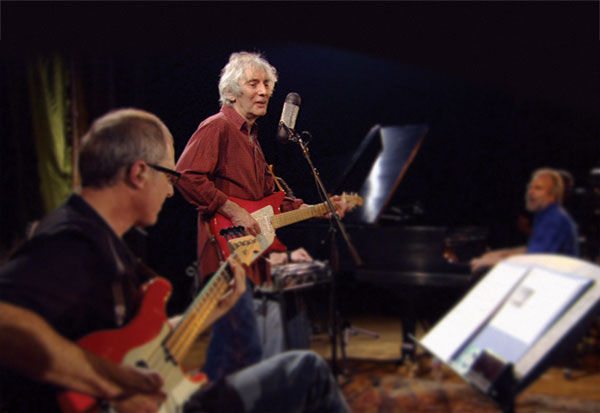
As with all surround recordings, the proof is in the mix, and unlike most such projects, Waldrep's releases offer two surround mixes. What Waldrep calls the "Audience" mix replicates the in-the-crowd feel of seeing a live show as a member of the audience. His "Stage" mix has the sonic perspective of being onstage with and among the band. Each is a combination of personal preference and hard-earned experience. (See the full review of Tearing It Up, our November "Recording of the Month.")
"There is no book, there is no model that says, okay, drums in the center, kick drum down the middle. We got that from vinyl—you had to have low frequencies in the middle. People don't realize that a lot of that mandated bass-in-the-center, lead-singer-in-the-center, drum-set-up-the-way came from vinyl limitations in mastering and cutting discs, not because of the creative outlet. With digital, we have basically anything you want.
"If you listen to any of the surround 'Stage' mixed tracks, certainly the ones that have drums, piano, that sort of traditional ensemble rhythm-section stuff, you're always going to find the drums on the right. The snare drum and hi-hat are at three, four o'clock in the 'Stage' mix. I record everything with stereo pairs, and so it's in that general right-hand half. I get complained at a lot about that, because people say, 'You know, it doesn't jibe. I see the drums on the left, visually.' Well, turn off the video part of the AIX release. Think of it as a record with video.
"I put the equivalent sound mass of a keyboard instrument on the left-hand side. I put a guitar, split them kind of left and right, ten o'clock and two o'clock. Put the star [performer] essentially in the middle, unless there's two of them, then we split them, eleven and one [o'clock]. I can close my eyes and imagine them, and with the stereo miking, the sound world that we create, they're here—they're playing for me.
 "It's me wanting to be in an after-hours club. The audience has gone home, and in walks Dinah Washington and in walks Lenny Bruce—it's two o'clock in the morning in a club back in the early '60s. You get that sort of intimate thing going on, which is what this is all about." (For much more about Waldrep and AIX, check out Michael Lavorgna's excellent in-depth interview for AudioStream.)
"It's me wanting to be in an after-hours club. The audience has gone home, and in walks Dinah Washington and in walks Lenny Bruce—it's two o'clock in the morning in a club back in the early '60s. You get that sort of intimate thing going on, which is what this is all about." (For much more about Waldrep and AIX, check out Michael Lavorgna's excellent in-depth interview for AudioStream.)
Waldrep admits that his "Stage" mixes can be jarring, even for devotees of surround sound, "I'm in trouble with reviewers in the world because, in general, they are far more traditional in their approach, and maybe audiophiles are as well. So I said, 'Okay, fine, it's not a problem for me to then do another mix.' This format [Blu-ray Disc] has multiple audio streams that are usually used for foreign-language dubs, that kind of thing. Let's put the band up in front of me, put myself in the best seat in the house, and [because] we're recording in a large chamber-music auditorium, I'll send the mikes, the B&Ks [Brüel & Kjaer] that I've got out there in the audience, I'll route those to the left and right surround speakers and give you that sense of [a] much more traditional [surround mix]."
Perhaps Waldrep's most controversial assertion regarding his philosophy of recording is when he claims that 80 to 85% of the people to whom he gives demonstrations of surround recordings of surround sound like the "Stage" mix better than the "Audience" mix—once they've gotten used to it.
"I had a guy from the Bay Area Audio Society tell me that the 'Stage' mix was uncomfortable for him. I gave him a sampler that had 29 tracks. He went home, forced himself to listen to the 'Stage' mix in his home theater in full surround, complaining the whole time—I could just hear the cranks working around upstairs. But as he got used to it and went through these different genres of music, he said to me, 'You know, I could pick out that acoustic guitar at three o'clock, I could pick out the marimba, I could pick out the vocal.' Things just became clear, so much so that when he flipped it back to the 'Audience' 5.1 [mix], he said the image just went flat—it was suddenly a painting rather than looking at a room full of people. He hit the bullet right on the head. At least the door was then open for him to acknowledge that maybe surround music is an alternative that some people could possibly enjoy. That's all I'm looking for."
Albert Lee, who had just seen and heard the completed Tearing It Up for the first time as this was going to press, found it "actually better than I'd remembered it," and says he's pleased with the overall product. His band for this disc was JT Thomas on piano, Bob Glaub on bass, and famed L.A. session drummer Don Heffington. Although JayDee Maness was his first choice for pedal-steel player, Randle Currie, who plays with Brad Paisley, filled in nicely.
Lee says the session had one glitch for him. "It was an unusual situation. It was like a large show with no audience, and I was a little uncomfortable in the fact that we didn't have any monitors—we had in-ear monitors. It was something I hadn't dealt with before."
Asked about the in-ear monitors, Waldrep says: "When you play the sound back into the monitor speakers for these people to hear each other, you diminish the audio potential from the listening, audiophile sensibility."
With a new band Lee's formed in Los Angeles that plays under his name, and Hogan's Heroes, the UK country-rock band he's played with for 25 years—not to mention side gigs like the Buddy Emmons tribute record he was about to fly off to contribute to—these days the guitarist has no shortage of work.
"I am busier now than I've ever been—with my UK band, which kind of works me to death, but I'm glad to have the work. And I'm still working with Bill Wyman. I've been with him for about 13 years. I think it's going to end at any time, but he still wants to go there and do it, and we get some reasonable tours. And now I've put together this US band, and I'm hoping the interest will grow, and from what we've done in the last few months it's looking very promising. And here I am, I'm 68 now, I'd really love to be home more, but I shouldn't complain. I can't afford to retire, and I think, with all this work, my playing has stayed at the same level, whereas the guys who have made a lot of money over the years playing guitar, I really believe they are not playing as well as they did when they started because they have too much time off."
Given his innate diffidence and rare humility, it's best left to others to pass final judgment on Albert Lee as a musician and a human being. An oft-quoted yet never confirmed summation from Emmylou Harris probably captures it best. And even if she didn't say it in quite these words, the gist seems right:
"A brilliant guitar player. His sound is unmistakable—often emulated, never equaled. When St. Peter asks me to chronicle my time down here on Earth, I'll be able to say (with pride, if that's allowed) that for a while I played rhythm guitar in a band with Albert Lee."
- Log in or register to post comments
